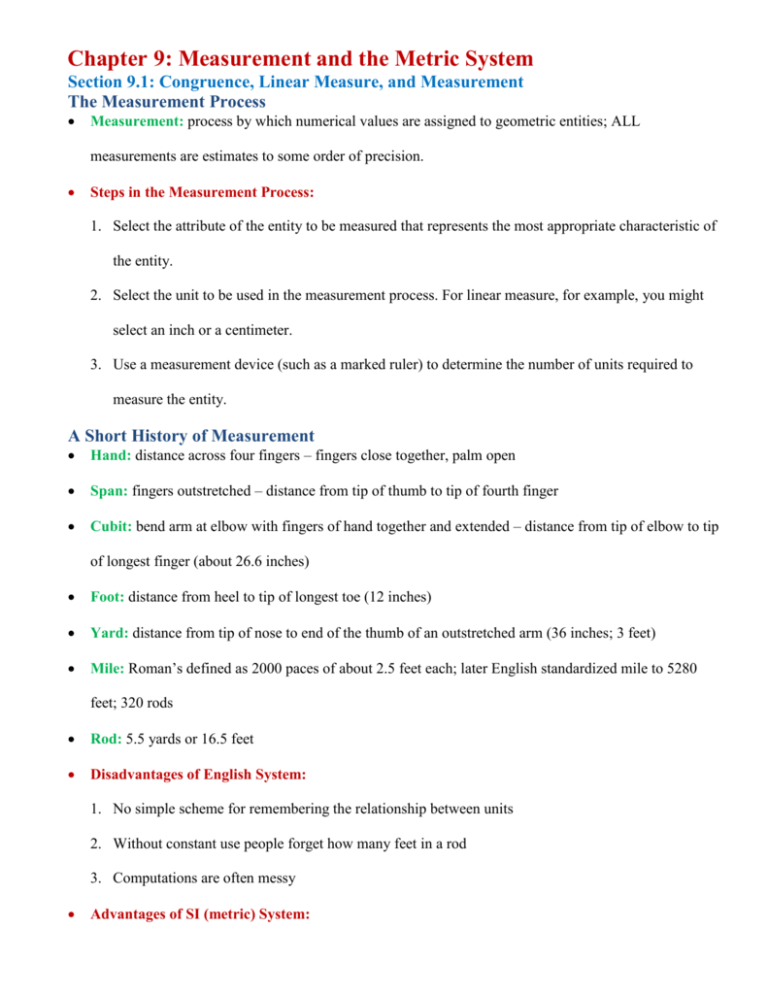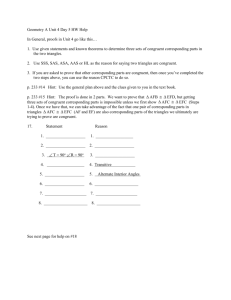Linear Measure
advertisement

Chapter 9: Measurement and the Metric System Section 9.1: Congruence, Linear Measure, and Measurement The Measurement Process Measurement: process by which numerical values are assigned to geometric entities; ALL measurements are estimates to some order of precision. Steps in the Measurement Process: 1. Select the attribute of the entity to be measured that represents the most appropriate characteristic of the entity. 2. Select the unit to be used in the measurement process. For linear measure, for example, you might select an inch or a centimeter. 3. Use a measurement device (such as a marked ruler) to determine the number of units required to measure the entity. A Short History of Measurement Hand: distance across four fingers – fingers close together, palm open Span: fingers outstretched – distance from tip of thumb to tip of fourth finger Cubit: bend arm at elbow with fingers of hand together and extended – distance from tip of elbow to tip of longest finger (about 26.6 inches) Foot: distance from heel to tip of longest toe (12 inches) Yard: distance from tip of nose to end of the thumb of an outstretched arm (36 inches; 3 feet) Mile: Roman’s defined as 2000 paces of about 2.5 feet each; later English standardized mile to 5280 feet; 320 rods Rod: 5.5 yards or 16.5 feet Disadvantages of English System: 1. No simple scheme for remembering the relationship between units 2. Without constant use people forget how many feet in a rod 3. Computations are often messy Advantages of SI (metric) System: 1. More convenient and consistent system of measure 2. Computations much easier because all based on powers of ten 3. Use prefixes with a standardized bases in increments of powers of ten Congruent Figures Tracing: an exact copy of a figure Congruent: two figures or two collections of points are congruent if they have the same size and same shape Linear Measure Congruent line segments are the mathematical basis for linear measure. Properties of Linear Measure: to every point on a number line, there corresponds exactly one real number, called its coordinate. Likewise, for every real number, there corresponds exactly one point, the graph of the number. Distance: If A and B are points on a number line with coordinates (real numbers) a and b, respectively, then the distance between A and B is given by |b – a|. The distance between A and B is sometimes called ̅̅̅̅ and is denoted by m(𝐴𝐵 ̅̅̅̅) = m(𝐵𝐴 ̅̅̅̅) = |b – a|. the measure of 𝐴𝐵 Congruent Segments: When two segments are congruent, their measures are equal; conversely, if their measures are equal, then the segments are congruent. Properties of Measure: ̅̅̅̅ ) ≥ 0 1. Distance is never negative; that is m(𝐴𝐵 2. The distance between two points is zero only when the points are identical ̅̅̅̅ ) = 3. The distance between points is unaffected by the order in which they are considered; that is m(𝐴𝐵 ̅̅̅̅). Hence forth we will write m(𝑨𝑩 ̅̅̅̅) as AB to mirror your book. m(𝐵𝐴 4. For any three noncollinear points A, B, and C, the distance between A and B plus the distance between B and C is greater than the distance between A and C; that is, AB + BC > AC. 5. If A, B, and C are three collinear points, with B between A and C, then AB + BC = AC. Triangle Inequality: For any three noncollinear points A, B, and C, AB + BC > AC. Measuring Length Meter: basic unit of linear measure in the SI system o 1 megameter (Mm) = 106 meters o 1 kilometer (km) = 1000 or 103 meters o 1 decimeter (dm) = 0.1 or 10-1 meters o 1 centimeter (cm) = 0.01 or 10-2 meters o 1 millimeter (mm) = 0.001 or 10-3 meters o 1 micrometer (µm) = 0.000001 or 10-6 meters Dimensional Analysis Dimensional Analysis: good technique for making conversions between units in a given measurement system; ALWAYS use ratios equal to 1 and treat ratios as fractions Perimeter Perimeter: P – the distance around a simple closed curve Precision Measures are approximations: 1. Estimated to a determined degree of precision, depending on the accuracy of the instrument 2. The process of reading a scale or ruler introduces uncertainty Greatest Possible Error (gpe): is half of the precision of the measure; for example, if measure to 5.3 m then actual measure is between 5.25 m and 5.35 meters, and the gpe is 0.05 Relative Error: Relative error is the greatest possible error of a number N divided by the number N: Relative Error of N = 𝑔𝑝𝑒 𝑜𝑓 𝑁 𝑁 . Exercise Sets: Homework: p. 434: 1ace, 2aceg, 3ac, 4ac, 5, 7aceg, 8ac, 10, 11, 12, 13aceg, 14ace, 16ac, 20ace, 21ace, 22, 23, 24 Blazeview: p. 434: 9, 15acegik, 17ace, 18





